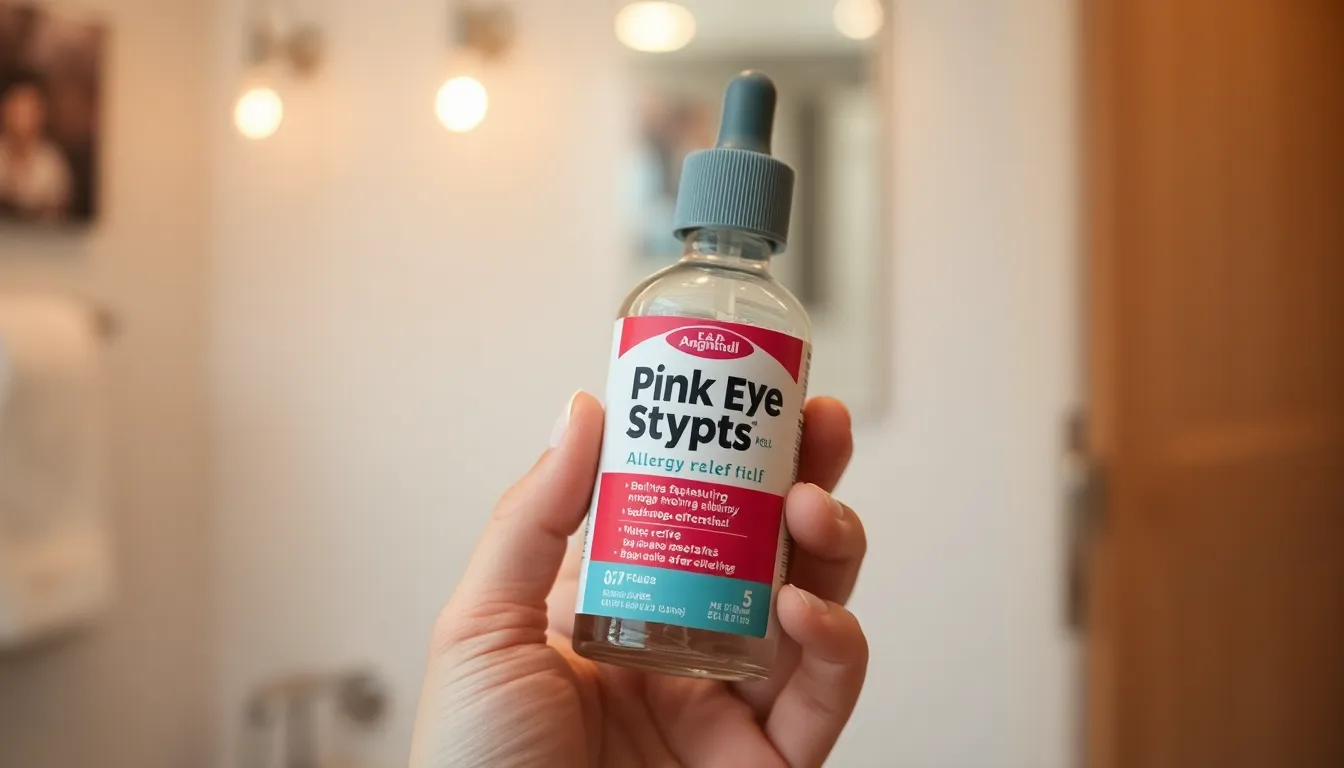Imagine waking up one morning with eyes that resemble a tomato—red, swollen, and oh-so-itchy. Pink eye, or conjunctivitis, might just be the uninvited guest that crashed your party. But fear not! Over-the-counter drops can swoop in like a superhero, saving the day and restoring your eye’s natural sparkle.
Table of Contents
ToggleOverview of Pink Eye
Pink eye, or conjunctivitis, affects the eyes, leading to discomfort. Understanding its types and symptoms helps in recognizing and addressing the condition effectively.
Types of Pink Eye
Bacterial conjunctivitis occurs when bacteria infect the eye. Viral conjunctivitis arises from a virus, often linked to upper respiratory infections. Allergic conjunctivitis stems from allergens like pollen or pet dander, causing irritation and redness. Other variants, like irritant conjunctivitis, develop from exposure to chemicals or foreign objects. Recognition of each type allows individuals to select appropriate treatments.
Symptoms of Pink Eye
Redness in the eye characterizes pink eye, usually accompanied by swelling. Itchy sensations often persist, leading to discomfort. Watery or thick discharge can occur, affecting vision. Photophobia, or sensitivity to light, may also develop, exacerbating discomfort. Identifying these symptoms aids in determining when to seek treatment or use over-the-counter eye drops.
Pink Eye Over The Counter Drops

Over-the-counter drops provide relief for pink eye symptoms and aid in recovery. Familiarity with the common ingredients and their mechanisms can enhance treatment choices.
Common Ingredients in Drops
Types of drops typically contain active ingredients like antihistamines, decongestants, and lubricants. Antihistamines work well for allergic conjunctivitis, alleviating itching and redness. Decongestants reduce redness by constricting blood vessels, making eyes appear clearer. Lubricants help combat dryness and irritation, allowing for more comfort. Some drops feature a combination of these components, offering multifaceted benefits. Always check labels to verify suitability for specific symptoms.
How They Work
Mechanisms behind over-the-counter drops differ by ingredient type. Antihistamines block histamine release, decreasing allergic reactions. Meanwhile, decongestants minimize redness through blood vessel constriction. Lubricating agents provide moisture, easing discomfort and irritation. Understanding these processes helps individuals select appropriate drops. Effectiveness varies with the pink eye type, so proper identification remains essential for optimal relief.
Benefits of Using Over The Counter Drops
Over-the-counter drops offer several advantages for those dealing with pink eye symptoms. These benefits include convenience, accessibility, and cost-effectiveness.
Convenience and Accessibility
Accessing over-the-counter eye drops is easy. They’re available in pharmacies and online, so users can obtain them without a prescription. Quick relief from symptoms can be achieved without needing an appointment with a healthcare provider. Plus, many brands offer different formulas, allowing users to choose based on their specific symptoms. People find it helpful that most eye drops come with user-friendly instructions, ensuring proper application. Finding the right product often means applying just a few drops to receive immediate comfort throughout the day.
Cost-Effectiveness
Purchasing over-the-counter eye drops saves money compared to prescription medications. Many drops cost significantly less than typical medical visits or specialized treatments. Various brands compete in the market, leading to options that cater to different budgets. Affordability allows users to stock up on multiple types if experiencing different symptoms. Patients often find that insurance may not cover prescription drops, making OTC alternatives more appealing. This cost-effectiveness enables timely treatment, helping individuals manage their symptoms efficiently without financial strain.
Potential Risks and Considerations
Using over-the-counter drops for pink eye comes with potential risks and considerations. Users must be aware of side effects associated with these treatments.
Side Effects
Side effects may occur with over-the-counter eye drops. Some individuals experience temporary burning or stinging upon application. Others may notice redness or irritation worsening instead of improving. Allergic reactions can happen as well, leading to swelling or increased discomfort. Users should check for nasal congestion or drowsiness with antihistamines. Awareness of these effects ensures proper monitoring for adverse reactions.
When to Consult a Doctor
Consulting a doctor becomes essential if symptoms persist beyond a few days. Eye pain that intensifies indicates the need for a professional evaluation. Discharge that is green or yellow also warrants immediate medical attention. Individuals experiencing vision changes must seek help promptly. Consulting a doctor for severe symptoms or repeated occurrences can help rule out complications. Recognizing these signs ensures appropriate treatment strategies are followed.
Over-the-counter drops provide a practical solution for managing pink eye symptoms. With various options available, individuals can find relief tailored to their specific type of conjunctivitis. Understanding the ingredients in these drops empowers users to make informed choices for effective treatment.
While these remedies offer convenience and affordability, it’s crucial to pay attention to potential side effects and know when to seek professional help. By recognizing the signs that warrant a doctor’s visit, individuals can ensure they receive the best care possible. With the right approach, managing pink eye can be straightforward and effective, allowing for a quicker return to comfort and normalcy.





